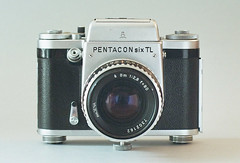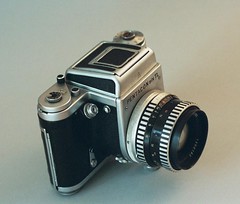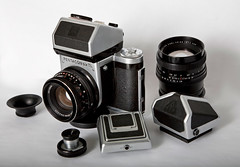Difference between revisions of "Pentacon Six"
(→Operation and frame spacing: adding last image) |
Nparsons13 (talk | contribs) m |
||
| (35 intermediate revisions by 13 users not shown) | |||
| Line 1: | Line 1: | ||
| − | + | <div class="floatright plainlinks"> | |
| + | {{Flickr_image | ||
| + | |image_source= http://www.flickr.com/photos/50678983@N00/179899560/in/pool-camerawiki | ||
| + | |image= http://farm1.static.flickr.com/58/179899560_22dfd12d99_m.jpg | ||
| + | |image_align= | ||
| + | |image_text= | ||
| + | |image_by= Dries van den Elzen | ||
| + | |image_rights= with permission | ||
| + | }} | ||
| + | </div> | ||
| − | + | The '''Pentacon 6''' is a [[medium-format]] system camera, an [[SLR]] that takes 6×6 pictures on [[120 film]]. It has been called an "SLR on steroids." Its predecessor was [[KW]]'s [[Praktisix]], with which it shares the bayonet mount. The famed [[Carl Zeiss]] Jena plant made lenses for this [[Pentacon Six mount]]. The Soviet factory [[Arsenal]] made a closely related camera called [[Kiev 6]] and later [[Kiev 60]]. | |
| − | + | <div class="floatleft plainlinks"> | |
| − | < | + | {{Flickr_image |
| + | |image_source= http://www.flickr.com/photos/50678983@N00/179899562/in/pool-camerawiki | ||
| + | |image= http://farm1.static.flickr.com/67/179899562_1c5fd5b08f_m.jpg | ||
| + | |image_align= | ||
| + | |image_text= | ||
| + | |image_by= Dries van den Elzen | ||
| + | |image_rights= with permission | ||
| + | }} | ||
| + | </div> | ||
| + | A basic kit consists of a Carl Zeiss Biometar 1:2.8 80mm lens, a simple matte screen, and a waist-level finder, but this is a system camera, and lenses from a 30mm fisheye to a 1000mm mirror objective are available. Lenses are still made and sold by [[Arsenal]] in Kiev (Arsat brand) and the Czech company Hartblei. | ||
| + | <div class="floatright plainlinks"> | ||
| + | {{Flickr_image | ||
| + | |image_source= http://www.flickr.com/photos/phil_et_al/3298146411/in/pool-camerawiki | ||
| + | |image= http://farm4.static.flickr.com/3410/3298146411_8e866179ec_m.jpg | ||
| + | |image_align= | ||
| + | |image_text= | ||
| + | |image_by= Ubiquitouscam | ||
| + | |image_rights= with permission | ||
| + | }} | ||
| + | </div> | ||
| + | Excellent [[Carl Zeiss]] Jena and [[Schneider]] lenses can be found at reasonable prices from the usual used camera sources. A variety of viewing screens, from simple matte to grids or fresnel screens, are available. The waist-level finder can be replaced by nonmetered or metered prism finders. The metered prisms were introduced in 1968; from that point onwards, the camera was called '''Pentacon six TL'''. Nothing had changed in the camera itself; the only thing new was the ''availability'' of a metered prism allowing TTL metering. | ||
| + | <br style="clear: both;" /> | ||
== Operation and frame spacing== | == Operation and frame spacing== | ||
| − | After the [[120 film]] is | + | After the [[120 film]] is loaded, the hinged door is closed, and the film is wound to (1) on the frame counter, the camera is ready to use. The Pentacon Six has a small switch under the advance lever to allow the use of 220 film. This film advance is reported by users on the internet to be the camera's weak point. |
| + | |||
| + | <div class="floatright plainlinks"> | ||
| + | {{Flickr_image | ||
| + | |image_source= http://www.flickr.com/photos/50678983@N00/463281922/in/pool-camerawiki/ | ||
| + | |image= http://farm1.static.flickr.com/224/463281922_d8a0793d75_m.jpg | ||
| + | |image_align= | ||
| + | |image_text= | ||
| + | |image_by= Dries van den Elzen | ||
| + | |image_rights= with permission | ||
| + | }} | ||
| + | </div> | ||
| − | + | Uneven frame spacing or overlapping frames have been reported. The frames are positioned with rather little margin between them. This is said to have been a design choice that would allow a ''thirteenth'' frame on 120 film. | |
| − | + | Another uncommon feature of the Pentacon Six, compared with other 6×6 cameras, is that the film moves ''horizontally'' through the camera. Most medium-format reflex cameras transport the film from top to bottom (or reverse), not from left to right. This has the pleasing effect of allowing the photographer to ''read'' a sequence of shots from left to right (rather than from top to bottom) when looking at developed film. | |
| + | |||
| + | Frame spacing in the Pentacon Six is largely determined by how tightly the film is wound. Users who experience problems with overlapping frames should calmly push the advance lever until further movement is blocked, ease the lever back (not let it snap back), and adjust the three white metal strips in the back to press the film more tightly (see picture). In most cases this will solve the problem. If not, a German company (see links) offers a modification that guarantees to solve it. | ||
| + | <br style="clear: both;" /> | ||
| + | |||
| + | == The shutter == | ||
| + | The Pentacon Six has a focal plane shutter with speeds of 1–1/1000s. It has a "B" setting and flash synchronization at 1/30s. This top shutter speed is not bad for a medium-format camera from the 1960s. Most medium-format cameras use central shutters, usually with top speeds of 1/500s. This focal-plane shutter allows lenses be produced more cheaply, since there is no need to build a shutter into each lens. An added advantage is that it is easier to build lenses with a larger aperture this way. | ||
---- | ---- | ||
<br> | <br> | ||
| + | {|class=plainlinks | ||
| + | ||[http://www.flickr.com/photos/50678983@N00/179899561/in/pool-camerawiki/ http://static.flickr.com/44/179899561_0bcbbaf713_t.jpg] | ||
| + | ||[http://www.flickr.com/photos/50678983@N00/179889155/in/pool-camerawiki/ http://static.flickr.com/56/179889155_0b5054f902_t.jpg] | ||
| + | |- | ||
| + | |colspan=3|''Pentacon Six with waist level finder'' | ||
| + | |- | ||
| + | |colspan=4 align="center"|<small>images by {{image author|Dries van den Elzen}}</small> {{with permission}} | ||
| + | |} | ||
| + | |||
| + | == Links == | ||
| + | === General links === | ||
| + | * [http://www.pentaconsix.com/ Pentacon Six website] by TRA | ||
| + | * [http://web.archive.org/web/20021014161504/http://medfmt.8k.com/mf/pentacon6.html Pentacon Six] at [http://web.archive.org/web/20021014161504/http://medfmt.8k.com/ medfmt] and [http://web.archive.org/web/20021014161504/http://medfmt.8k.com/mf/go1.html#pentacon review by Danny Gonzalez] | ||
| + | * [http://www.mflenses.com/gallery/v/german/zeiss/biometar_120/ Carl Zeiss Jena Biometar 120mm f/2.8 Lens Gallery] at [http://www.mflenses.com www.mflenses.com] | ||
| + | * [http://www.butkus.org/chinon/pentacon/pentacon_sixtl/pentacon_sixtl-splash.htm PDF manual for Pentacon Six TL PDF manual] on www.orphancameras.com | ||
| + | * [http://www.collection-appareils.fr/x/html/page_standard.php?id_appareil=11047 Pentacon Six TL] on [http://www.collection-appareils.fr/general/html/francais.php www.collection-appareils.fr] by Sylvain Halgand | ||
| + | |||
| + | === Repairs and technical info === | ||
| + | * [http://www.baierfoto.de/index.html#english Baier Fototechnik] has [http://www.baierfoto.de/transportengl.html tips] and [http://www.baierfoto.de/Messengl.html technical information] about the overlapping frame problem and sells devices to fix it | ||
| + | * [http://rick_oleson.tripod.com/index-129.html How to remove the top plate and attach strap lugs] and [http://rick_oleson.tripod.com/index-31.html how to make an adapter to mount Kalimar lenses], in [http://rick_oleson.tripod.com/ Rick Oleson's website] | ||
| − | |||
| − | |||
| − | |||
| − | |||
| − | |||
| − | |||
| − | |||
| − | + | {{P6}} | |
| − | |||
| − | |||
| − | |||
| − | |||
| − | |||
| − | |||
| − | |||
| − | |||
| − | |||
| − | [[Category: 6x6 SLR]] | + | [[Category:German 6x6 SLR]] |
| − | [[Category: | + | [[Category:Pentacon|Six]] |
| − | + | [[Category: S|Six Pentacon]] | |
| − | [[Category: Pentacon]] | ||
[[Category: P]] | [[Category: P]] | ||
Latest revision as of 13:37, 19 September 2022

|
| image by Dries van den Elzen (Image rights) |
The Pentacon 6 is a medium-format system camera, an SLR that takes 6×6 pictures on 120 film. It has been called an "SLR on steroids." Its predecessor was KW's Praktisix, with which it shares the bayonet mount. The famed Carl Zeiss Jena plant made lenses for this Pentacon Six mount. The Soviet factory Arsenal made a closely related camera called Kiev 6 and later Kiev 60.

|
| image by Dries van den Elzen (Image rights) |
A basic kit consists of a Carl Zeiss Biometar 1:2.8 80mm lens, a simple matte screen, and a waist-level finder, but this is a system camera, and lenses from a 30mm fisheye to a 1000mm mirror objective are available. Lenses are still made and sold by Arsenal in Kiev (Arsat brand) and the Czech company Hartblei.

|
| image by Ubiquitouscam (Image rights) |
Excellent Carl Zeiss Jena and Schneider lenses can be found at reasonable prices from the usual used camera sources. A variety of viewing screens, from simple matte to grids or fresnel screens, are available. The waist-level finder can be replaced by nonmetered or metered prism finders. The metered prisms were introduced in 1968; from that point onwards, the camera was called Pentacon six TL. Nothing had changed in the camera itself; the only thing new was the availability of a metered prism allowing TTL metering.
Contents
Operation and frame spacing
After the 120 film is loaded, the hinged door is closed, and the film is wound to (1) on the frame counter, the camera is ready to use. The Pentacon Six has a small switch under the advance lever to allow the use of 220 film. This film advance is reported by users on the internet to be the camera's weak point.

|
| image by Dries van den Elzen (Image rights) |
Uneven frame spacing or overlapping frames have been reported. The frames are positioned with rather little margin between them. This is said to have been a design choice that would allow a thirteenth frame on 120 film.
Another uncommon feature of the Pentacon Six, compared with other 6×6 cameras, is that the film moves horizontally through the camera. Most medium-format reflex cameras transport the film from top to bottom (or reverse), not from left to right. This has the pleasing effect of allowing the photographer to read a sequence of shots from left to right (rather than from top to bottom) when looking at developed film.
Frame spacing in the Pentacon Six is largely determined by how tightly the film is wound. Users who experience problems with overlapping frames should calmly push the advance lever until further movement is blocked, ease the lever back (not let it snap back), and adjust the three white metal strips in the back to press the film more tightly (see picture). In most cases this will solve the problem. If not, a German company (see links) offers a modification that guarantees to solve it.
The shutter
The Pentacon Six has a focal plane shutter with speeds of 1–1/1000s. It has a "B" setting and flash synchronization at 1/30s. This top shutter speed is not bad for a medium-format camera from the 1960s. Most medium-format cameras use central shutters, usually with top speeds of 1/500s. This focal-plane shutter allows lenses be produced more cheaply, since there is no need to build a shutter into each lens. An added advantage is that it is easier to build lenses with a larger aperture this way.

|

| ||
| Pentacon Six with waist level finder | |||
| images by Dries van den Elzen (Image rights) | |||
Links
General links
- Pentacon Six website by TRA
- Pentacon Six at medfmt and review by Danny Gonzalez
- Carl Zeiss Jena Biometar 120mm f/2.8 Lens Gallery at www.mflenses.com
- PDF manual for Pentacon Six TL PDF manual on www.orphancameras.com
- Pentacon Six TL on www.collection-appareils.fr by Sylvain Halgand
Repairs and technical info
- Baier Fototechnik has tips and technical information about the overlapping frame problem and sells devices to fix it
- How to remove the top plate and attach strap lugs and how to make an adapter to mount Kalimar lenses, in Rick Oleson's website
| Praktisix and Pentacon Six lens mount | ||
|---|---|---|
| Germany | | | Ukraine |
| Exakta 66 | Pentacon Six | Praktisix | | | Kiev 6C | Kiev 60 | Kiev 88СМ | Arax |